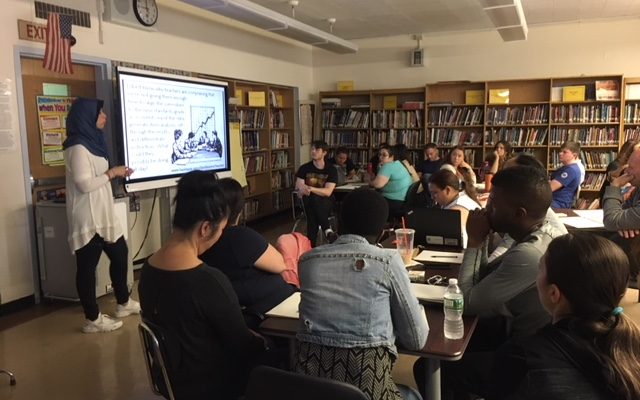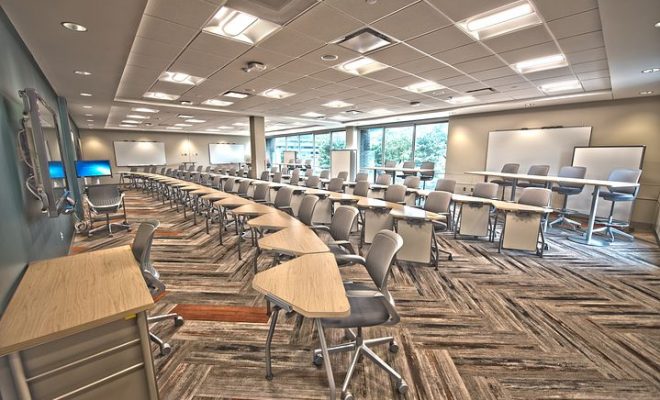STEM: Attitude Adjustment Required

As STEM careers continue to rise in demand, America is lagging behind. Can we even begin to change the trajectory so that we can compete with countries like India and Korea on a global level? It’s possible for us to change the tide, but we need to change our attitudes first.
STEM (or Science, Technology, Engineering and Mathematics) careers are on the rise. Over the next decade, for instance, the number of computer science jobs in the U.S. will outnumber qualified people by 1 million. That’s 1 million jobs for the taking that Americans will miss out on because of inadequate skill sets.
Yet interestingly, for the 2014 fiscal year, under proposed budget changes, many STEM educational initiatives were pushed out of existence.
Overall funding for STEM programs was actually supposed to rise by $3 billion, or 6 percent. However, consolidation of STEM education would leave specific programs out in the cold. For example, $15 million in funding goes toward the Science Education Partnership Awards funded by the National Institutes of Health. However, that was not included in the proposed budget changes. Every year the awards provide over 75,000 K-12 students with informal, hands-on science education intended to spark lifelong interest in an area where America consistently lags behind other developed countries.
STEM is not a priority for Americans—not yet, anyway. The easiest thing to do is to blame the Obama administration and the budget advisors on this particular project, but the issue is much, much bigger than Obama.
A report released in December 2012 called Trends in International Mathematics and Science Study showed that just 7 percent of U.S. students had advanced level eighth-grade math skills, compared with 47 percent in South Korea and 48 percent in Singapore. Further, the U.S. was ranked as 11th in fourth-grade math and 9th in eighth-grade math. American students ranked higher in reading, but still fell behind Hong Kong, Russia and Finland.
When test results such as these are released, there is usually an initial public outcry about the slipping state of the American public in science and math. However, those voices quickly fade, content to download another smartphone app that does metric conversion or even one that is advertised to complete math homework with a few taps of a touchscreen.
See where the disconnect is coming from? It is easier to consume technology than to learn how to tackle the equations and other much-needed skills that would enable us to enhance and create technology.
What gives?
Indifference toward STEM initiatives is not just caused by an uneducated public. It’s not caused by the convenience of Internet technology. (In fact, later on I will actually show you how advances in technology are actually helping us make STEM careers more accessible and fun to students.) It’s not even our favorite scapegoat, the media.
The truth is that Americans have an attitude problem. This indifference toward STEM is a byproduct of academic disengagement, fueled by the way children are taught in American K-12 schools. As interactive technology becomes commonplace in classrooms, education becomes more of a form of entertainment. Yes, educators should find innovative ways to reach students with educational messages. But there is a blurry line between creative learning and babysitting tactics to keep students from declaring boredom.
Are math, science, engineering and technology topics simply too complicated for the short attention spans of today’s American K-12 students? Even worse, do educators add to this problem by spending too much time trying to put on a song and dance? My answer to both of these questions is “yes.”
I am not blaming educators. Rather, I am pointing out that they are in a quandary made possible by an issue that has been empowered by, ironically, technology. Screen culture rules. So does an education system that favors standardized learning over intellectualism. Our educational system emphasizes fact memorization instead of placing a priority on hands-on math and science experiences. As a result, 46 percent of Americans believe that young people do not pursue math and science careers because they are “too hard.” In the same Pew Research study, 20 percent of American said careers in science and math are “too boring.”
Too boring? How can science, the intricate study of how things work in our known (and unknown) universe, be boring? How can math, or how things balance out and make our world run smoothly, be too complicated to pursue? These questions bring up even more questions, and it often seems like there are not enough people who care enough to look for answers.
Thankfully, it seems like on a national level, we are finally getting the picture.
It starts with the president
During the 5th annual White House Science fair, President Barack Obama announced $240 million in Science, Technology, Engineering and Math (STEM) funding would come from private businesses, foundations and schools.
Obama called the National Science Fair “the most fun event of the year” and praised the sophistication of the projects presented from scientists as young as Kindergarten. He emphasized the need for society to keep pushing STEM initiatives, through vocal and financial support and said that this generation of students will “define the contours of the 21st Century” through their advancements.
President Obama has always been a big proponent of STEM learning and initiatives. Since the start of his first term, he has pushed for higher accountability in schools where these subjects are concerned and has also looked for ways to funnel funding towards them. Schools with strong STEM programs, for example, see more Race to the Top funding. Keeping up with other countries when it comes to STEM initiatives is a priority for the President and he sees the long term economic value in encouraging students today.
Why should schools make computer science a priority?
As it stands, over the next decade, 1 million extra computer science jobs will remain unfilled in America.
That job availability would be a great sign, were it not for the fact that many Americans go into the workforce fully unprepared for that kind of work. And in spite of all this, only 10 percent of K-12 schools have computer science programs.
The root of the problem is pretty simple. Traditional subjects like English and math receive a lot of play time in K-12 classrooms and they are considered “building blocks” for other subjects, like computer science. So when a high school senior decides to seek out a college degree in English, or mathematics, he or she has a general idea of what to expect in the classes that follow. The same can be said for arts-based topics, like the visual arts or music. Feasibly a young person accepted to college for those topics has had several years of training in it and plans to build on that base knowledge.
The same is not necessarily true for computer science majors
If only 10 percent of schools are teaching computer science courses (and we don’t know how extensive those programs may be), then it’s a safe bet that many of the kids entering those college classes have no idea what to expect. Or even worse – young people who may show promise in computer science never realize their potential because there is never a primer class to alert them to it. Despite its prevalence in the “real world,” computer science classes on K-12 campuses are not much changed from a decade or two ago.
To add to this, K-12 schools—especially public ones—adopt new technologies slowly. Classroom computers are nothing new but the science behind today’s careers is constantly evolving. It is difficult for classrooms to find the resources to keep up with the changing face of computer science. In some cases, by the time a particular technology is obtained or curriculum purchased, it is already on its way out the door as being considered cutting-edge. It can feel overwhelming, and frustrating, and this red tape keeps technology from reaching students’ hands in a reasonable time frame.
There are solutions to this problem
And not only will I make some suggestions, but I will also give real-life examples of schools that are better preparing their students for STEM careers (including but not limited to computer science).
But first my suggestions: To meet the computer science job demand, K-12 schools will need help from outside partners. This could come in the form of area businesses willing to donate needed technology to make more classes happen or curriculum partnerships with groups like Code in the Schools. If every computer science classroom tries to re-invent the wheel, a lot of time and resources are wasted. So asking for help is the first step.
There also needs to be a larger focus on computer science at a younger age. This does not just mean computers and mobile devices available in K-12 classrooms but should include lessons on the “how” of the technology. The site Code.org has basic coding activities for children as young as Kindergarten – so teachers should be taking advantage of these resources. Waiting until middle or high school is simply too long to wait to spark an interest in K-12 students in computer science.
Finally, special attention should be paid to getting young women interested in computer science learning. Research tells us that girls are just as adept as boys at learning STEM topics, computer science included, but their interest tends to drop off in late elementary or middle school. Knowing this, educators should make sure girls are exposed to the same computer science learning as boys and encouraged through organizations like Girls Who Code. It may still take a generation to get to the point where young women feel completely comfortable seeking out computer science opportunities, so in the meantime support systems need to be there.
Now let’s look at the initiatives schools are using to encourage students to pursue STEM careers before they get to college.
Schools that are changing attitudes toward STEM careers
In Lanham, Maryland, DuVal High school is now offering its students the opportunity to take an Aerospace Engineering and Aviation Technology class.
Nearly 70 students, including 15 girls, are in the first class of the specialty program, which is part of a STEM offering to encourage more students to embrace these fields.
Located just minutes from DuVal, NASA and the College Park Aviation Museum are serving as partners and working to expose students to career options they may otherwise overlook.
Chairman on the Prince George’s County School Board, Segun C. Eubanks said that the program is like other career academies that have opened across the country, part of an ongoing effort by school system to expose students to these high-demand fields and prepare them for college and their careers.
Eubanks made an interesting statement, one that is important to changing the attitudes of American students toward STEM careers:
“Rather than just explain to them why they need algebra skills in the ninth grade, this shows them.”
The academies began in Prince George’s three years ago, and are an integral component of the county’s secondary school reform. In those three years, it has opened 36 career-focused academies, offering 12 career options to 3,400 students who participated in the specialty programs last year.
School chief Kevin Maxwell said the program will give students a competitive edge when they apply for college, especially if they decide to pursue a career in engineering or aviation.
The Aerospace Engineering Program at DuVal High School is a remarkable opportunity that will expose high school students to STEM subjects and provide hands-on learning. I anticipate the program, especially in partnership with NASA, will help encourage more young adults to pursue careers in STEM-related fields.
The Florida Institute of Technology is also dedicated to helping K-12 students reconsider the role of science and math in their lives. It hopes to inspire students to seek out careers in science, technology, engineering and math and has started a poster outreach campaign to make that happen. Florida Tech’s Office of Enrollment Management is sponsoring a program that has already sent 13,700 posters to teachers across the country that poses one very important query: What if there were no moon? The hypothetical question comes with many facets attached and employs class discussion, mathematical calculations and scientific thinking.
The poster is more than just a wall-hanging, though. It features a lesson plan that outlines ways to use physics, math and geology to calculate the mass of the moon. Three faculty members developed the lesson plan that was then reviewed and refined by Master Teachers before it was sent out to teachers nationwide.
This isn’t the first time Florida Tech has reached out to teachers to help with in-classroom STEM initiatives. Other posters that have been created and distributed in previous years include The Power Of Math (based upon the science and math behind speedboat design); Gridiron Science (the math and physics of football); Science in Music (STEM career fields used in music); and Career Options in Sustainability.
Institutions of higher education that specialize in STEM learning, like Florida Tech, certainly recognize that its next generation of students will need to arrive on campus with a much larger knowledge set than even a few years ago. Careers in STEM fields represented 6.2 percent of the total U.S. workforce in May of 2014 and those numbers are predicted to grow steeply through 2020, according to the U.S, Department of Labor.
That work begins long before a college career, though, and outreach like this poster program helps build the STEM foundation that will be needed as a college student and beyond.
What role does technology play in enhancing STEM learning?
I have briefly discussed some of the negative “side effects” that using technology has had on our national attitudes toward STEM. However, this discussion would not be complete without mentioning a few ways in which technology can actually help with learning STEM topics.
There are many, many technologies that make learning STEM easier and more fun, but here are just three of them:
Virtual laboratories: Scientific experiments are no longer just reserved for physical labs. Through interactive technology, students can now do experiments remotely through use of virtual laboratories. The virtual labs at New Mexico State University, for example, give high school and college students’ access to food-based experiments. Students can test for corn mold, milk bacterial contamination and prevent C. Bot growth in salsa from a remote website. There is certainly something to be said of in-person experimentation, but student access is usually limited based on actual class times and resources. A virtual lab means that a student can do an experiment multiple times, and learn from mistakes in real-time and make adjustments. It also means that experiments are not limited to a determined class time and can be done on a student’s schedule. So students with an appetite for experimentation have greater access to it, and the others are not easily discouraged by “one shot” experiments.
In-class mobile devices: A student with a tablet or smartphone in hand has a portal to hundreds of apps that support STEM learning. There are a lot of things that students can do on basic tablets and phones, but there are also products like the einstein Tablet+ from Fourier Education that have a specific focus on STEM initiatives. Instead of going out and searching for STEM-centric lessons, the einstein Tablet+ comes preloaded with experiments and modules that cover physics, biology, human physiology, chemistry, and environmental science. This STEM-specific tablet can be connected to classroom projectors and monitors so that all the students can participate at once, or can be used as an individual tablet for customized learning in grades K-12. Teachers can search mobile apps for highly-reviewed ones, some of which are completely free, to use on the screens in their classrooms.
Television programming: Yes, it’s true that children watch too much television already. Kids ages 8 to 18 are still watching television programs on various screens for 4.5 hours a day. This is despite all the statistics that say that too much television watching among children leads to higher obesity rates, behavior problems and less interest in things like reading.
It doesn’t have to be all bad news, though. The value of children’s programming is increasing. Programming is no longer created for the purpose of entertainment alone. On PBS alone, STEM-learning programs like Sid the Science Kid, Curious George, Cyberchase, Nature and Nova run the gamut of childhood ages and interests. In some cases, teachers are even able to incorporate some of these learning programs in classrooms and build entire lesson plans around the content.
Math, science and engineering are all intrinsically linked with technology. This gives educators an advantage with the current generation of K-12 students who arrive in Kindergarten classrooms with a technological edge. As learning technology improves, STEM education will continue to be the beneficiary if educators use it resourcefully.
Tying it all together: Using technology and STEM to improve the English language skills of ESOL students
Let’s look at a brilliant example of what happens when we use technology right and make STEM topics more accessible to K-12 students.
Middle school is challenging enough as it is. Students are making the transition from elementary school and have to adjust to the many physical and emotional changes they are undergoing. And for English language learners, the challenges are even greater. Not only do these students have to learn how to speak, read and write a new language, they have to adjust to a new culture.
At Hunter’s Creek Middle School, in Orlando, Florida, the 165 ESOL students speak 32 different languages. Yet the school’s students are gaining confidence and language skills using STEM and project-based learning (PBL).
According to Hunter’s Creek ESOL teacher Yvette Ramirez, “Project based learning is a good fit with ESOL because it gives students an opportunity to dive deep into a topic and really spend time with it. They also get to practice their language skills in a variety of ways from listening to and watching videos to reading articles and writing their own content.”
All of Hunter’s Creek’s students work exclusively on iPads. On the rare occasions when Ms. Ramirez asks her the kids to take out a piece of paper “they look at me strange because they want to use the iPads. We’re not just using digitized work. We are digital.”
Ms. Ramirez is using one of the digital curriculum programs that came pre-loaded on the school’s iPads to implement PBL in her STEM lessons. Defined STEM is an online program that provides educators with resources to create engaging, relevant, cross-curricular PBL lessons. “One of the great things about Defined STEM is that the students are able to access the lesson directions and rubric in many different languages,” said Ms. Ramirez. “But, all of the articles, videos and other supporting content are in English. So students can feel comfortable that they understand the directions by reading them in their own languages but must use their English skills to actually complete the assignments.”
During the 2014-15 school year, Ms. Ramirez’s ESOL students worked on several STEM projects. The project that generated the most excitement and engagement was Defined STEM’s Culinary Artist: Sustainability performance task. The Developmental Language Arts class, which is for students who speak very little English, worked on the project.
The goal of the project was for students create their own farm-to-table restaurant, including deciding where to locate the restaurant geographically, what to farm, how to farm, and ultimately what the menu would be. “Defined STEM had a lot of articles and videos within students’ Lexile levels that helped them get started but then they had to go find additional resources outside of Defined STEM,” shared Ms. Ramirez. “Students researched healthy recipes and figured out what kind of gardens they needed and where in the country they needed their gardens to grow.”
The Culinary Artist project culminated in students presenting the commercials and TV interviews they created that showcased their unique farm-to-table concepts. “These students have influences from around the world which they got to show in their menu and food choices,” said Ms. Ramirez. “So even though the project really helped them build their English skills and gain knowledge about American culture and geography, the students still were able to incorporate a bit of home.”
Ms. Ramirez has a strong background in teaching ESOL students and believes that a digital PBL STEM curriculum is a highly effective method to teach students both language and curricular skills. A common approach to teaching ESOL students is to pair a student with stronger language skills with a struggling student. This helps them both build their skills. PBL facilitates this kind of collaborative learning. “Without Defined STEM it would have been much harder to do these types of complex, lengthy STEM projects. All of the resources are there and designed to support English language learners. Plus, Defined STEM makes the performance tasks so interesting and intriguing that even when the work gets tough, the students persevere because they’re totally engaged.”
“The Culinary Artist projects were amazing,” shared Ms. Ramirez. “The students worked so hard and really deepened their understanding not only of English but of technology, geography, math, and so much more. They were so proud of themselves and that is exactly how I want my students to feel when they walk out of my class.”
The bottom line about STEM in America
We need to prioritize it. But even more than that, we need to find a way to make STEM topics more fun, accessible, and understandable to students in a global economy that prizes STEM-related contributions.
For years, we have struggled to do this. Fortunately, the tide is finally changing.
I look forward to seeing what will happen over the next several years.





